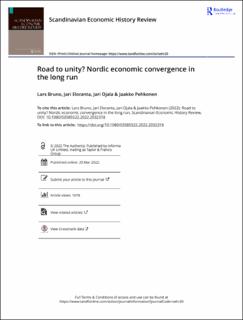Road to unity? Nordic economic convergence in the long run
Peer reviewed, Journal article
Published version
Permanent lenke
https://hdl.handle.net/11250/3067529Utgivelsesdato
2022Metadata
Vis full innførselSamlinger
- Scientific articles [2181]
Sammendrag
This study examines Nordic economic convergence from the sixteenth to twentieth century respective of the economic leaders, in effect the UK before 1914 and USA thereafter. The paper uses a novel approach of combining the analysis of both GDP and wages. The examination of real GDP per capita suggests that there was a catch-up process in play, both with the economic leaders and among the Nordic states, from the early nineteenth century onwards. However, the examination of the adjusted silver wages suggests convergence among the Nordic economies by the end of the eighteenth century. Therefore, we argue, no single Nordic Model emerged from these development patterns, even though the Nordic states today do have striking similarities. Furthermore, they diverged from the West European growth path until the twentieth century, thus they were a part of the Little Divergence at Europe’s other peripheries. The world wars and other crises delayed the full impacts of the convergence process until the latter part of the twentieth century.

